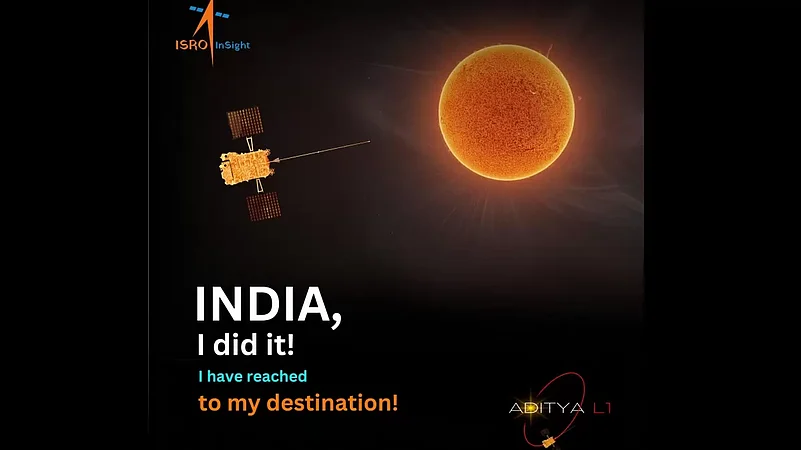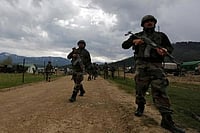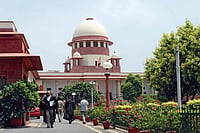ISRO successfully placed the solar observatory Aditya-L1 spacecraft in its final destination orbit on Saturday.
Prime Minister Narendra Modi announced the achievement saying, "India creates yet another landmark, country's first solar observatory Aditya-L1 reaches its destination."
He further stated, "It is a testament to the relentless dedication of our scientists in realising among the most complex and intricate space missions. I join the nation in applauding this extraordinary feat. We will continue to pursue new frontiers of science for the benefit of humanity."
The space agency ISRO performed the final manoeuvre to inject Aditya-L1 spacecraft—the first space-based Indian observatory to study the Sun—into its final destination orbit, some 1.5 million kilometres from the Earth.
According to ISRO officials, the spacecraft was placed in a halo orbit around Lagrange point 1 (L1) of the Sun-Earth system, about 1.5 million km from the Earth, PTI reported.
The L1 point is about one per cent of the total distance between the Earth and the Sun.
A satellite in a halo orbit around the L1 point has the major advantage of continuously viewing the Sun without any occultations/eclipses, they said, adding, this will provide a greater advantage in observing solar activities and its effect on space weather in real time.
"This manoeuvre (at around 4 pm on Saturday) will bind the Aditya-L1 to a halo orbit around L1. If we don't do this, there is a possibility that it will continue its journey, maybe towards the Sun," an ISRO official said.
The Polar Satellite Launch Vehicle (PSLV-C57) launched the Aditya-L1 spacecraft from the second launch pad of Satish Dhawan Space Centre (SDSC), Sriharikota, on September 2 last year.
After a flight duration of 63 minutes and 20 seconds, it was successfully injected into an elliptical orbit of 235x19500 km around the Earth.
The spacecraft underwent a series of maneuvers thereafter and headed Sun-Earth Lagrange Point 1(L1), having escaped the Earth's sphere of influence.
The spacecraft carries seven payloads to observe the photosphere, chromosphere and the outermost layers of the Sun (the corona) using electromagnetic and particle and magnetic field detectors.
"Using the special vantage point L1, four payloads directly view the Sun and the remaining three payloads carry out in-situ studies of particles and fields at the Lagrange point L1, thus providing important scientific studies of the propagatory effect of solar dynamics in the interplanetary medium," according to the space agency.
The suits of Aditya L1 payloads are expected to provide the "most crucial information" to understand the problem of coronal heating, coronal mass ejection, pre-flare and flare activities and their characteristics, dynamics of space weather, and propagation of particles and fields, officials said.
The major science objectives of the Aditya-L1 mission are:
- Study of the Solar upper atmospheric (chromosphere and corona) dynamics.
- Study of chromospheric and coronal heating, physics of the partially ionized plasma, initiation of the coronal mass ejections, and flares.
- Observe the in-situ particle and plasma environment, providing data for the study of particle dynamics from the Sun.
- Physics of the solar corona and its heating mechanism.
- Diagnostics of the coronal and coronal loops plasma: Temperature, velocity and density.
- Development, dynamics and origin of coronal mass ejections (CMEs).
- Identify the sequence of processes that occur at multiple layers (chromosphere, base and extended corona) which eventually leads to solar eruptive events.
- Magnetic field topology and magnetic field measurements in the solar corona.
- Drivers for space weather (origin, composition and dynamics of solar wind).
People react to ISRO's feat
President Droupadi Murmu lauded the entire scientist community for the achievement. "This mission will enhance our knowledge of the sun-earth system and benefit the entire humanity. Significant participation of women scientists in ISRO missions takes women empowerment too onto a higher orbit," Murmu said.
Calling it 'end of a long journey', the chief of ISRO S Somnath said, "126 days from lift-off to now…it has reached the final point. So reaching the final point is always, an anxious moment, but we were very sure about it. So, it happened as predicted. We are very happy."
He reportedly added, “It was a complex mission, I won't say challenging mission. Challenges are something that we love, complexities are something that we have to overcome. Today, we have overcome the complexity, and we were able to achieve that very precisely…Payloads are working very well, but now many more things are to be done on payloads to make sure that the data is reliable and usable, so that will start from now.”
Union Home Minister Amit Shah said, "Another milestone in Bharat's journey through space!! Our first solar observatory Aditya-L1 reaches its destination in space. It is a momentous event in history that takes us closer to our civilisational goal of achieving human welfare through excellence in science and technology."
"From moon walk to sundance," remarked Union Science and Technology Minister Jitendra Singh, recalling the Indian Space Research Organisation's (ISRO) successes ranging from the lunar landing of the Chandrayaan-3 mission, the recent launch of the XPoSat satellite and the placing of Aditya-L1 in the desired orbit.
Singh underlined the importance of studying space weather and cited the example of SpaceX losing 40 satellites last year when those ran into a solar storm.
"We have a number of satellites operating and therefore it is imperative for us to discover the various phenomena emanating from the sun -- the magnetic fields, the occurrence of solar storms. Now, what Aditya-L1 is going to feed us with is something that the rest of the world will also be looking forward to," the minister said.
Nilesh Desai, Director, Space Applications Centre (SAC/ISRO), Ahmedabad reacting on the success of the Aditya L1 mission said, "In an operation that lasted 220 seconds, we were able to achieve the Halo Orbit Insertion of the Aditya L1 mission. With this, India became the 4th country in the world to have a solar observatory. We will be getting uninterrupted information about the Sun and space weather for the next 5 years. The major benefit from the mission is that during the period of 2025 to 2028, when the solar activities will be at the peak due to the sun cycle, we will get the chance to study the Sun."
ISTRAC Bengaluru Director R Rama Krishna told PTI, "ISTRAC has been providing data from the time where we lift off from the launchpad, till today when we have inserted Aditya-L1 into the Halo orbit. The data being provided by ISTRAC is very important in monitoring the health of the satellite, as well as tracking and determining the orbit."


























